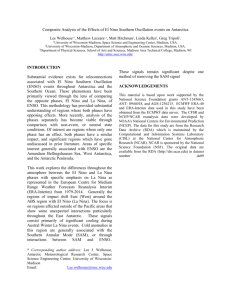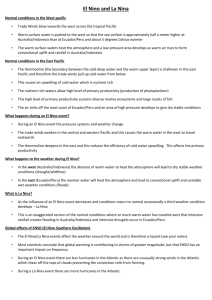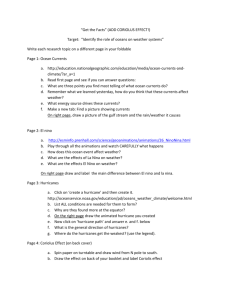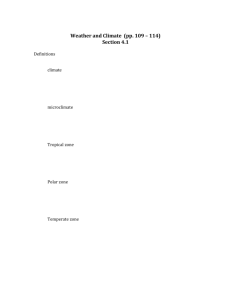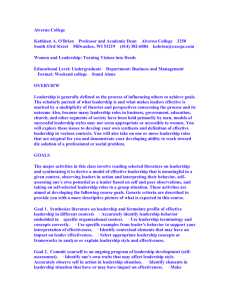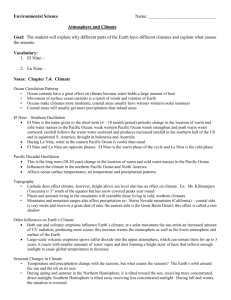El Nino and La Nina Assessment
advertisement
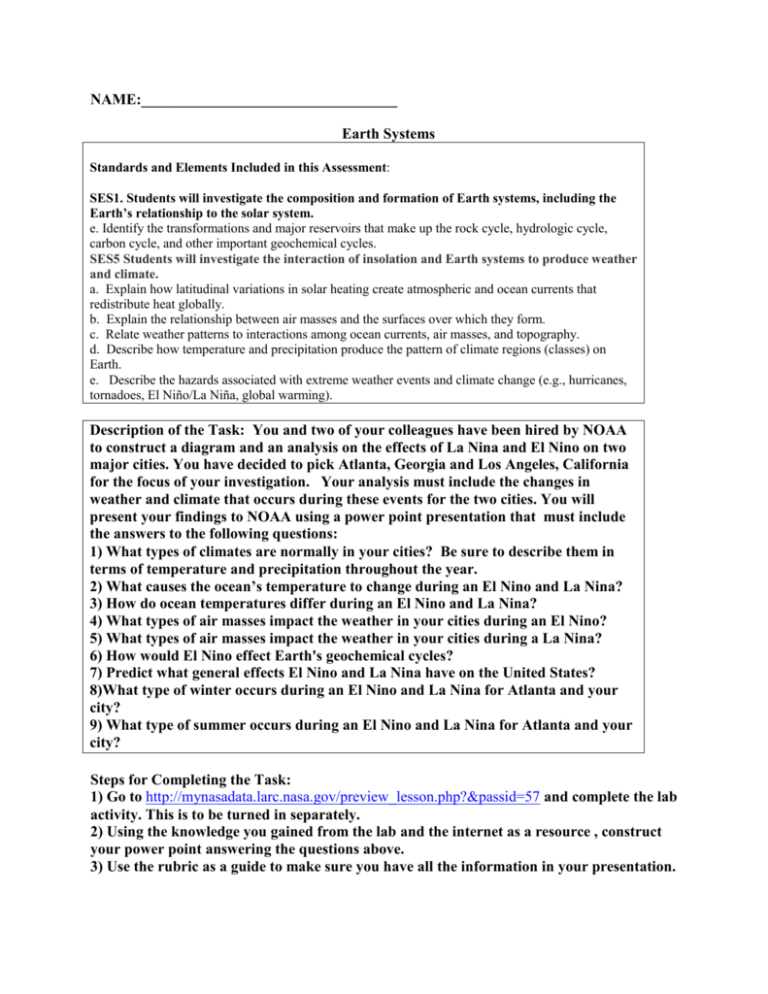
NAME:__________________________________ Earth Systems Standards and Elements Included in this Assessment: SES1. Students will investigate the composition and formation of Earth systems, including the Earth’s relationship to the solar system. e. Identify the transformations and major reservoirs that make up the rock cycle, hydrologic cycle, carbon cycle, and other important geochemical cycles. SES5 Students will investigate the interaction of insolation and Earth systems to produce weather and climate. a. Explain how latitudinal variations in solar heating create atmospheric and ocean currents that redistribute heat globally. b. Explain the relationship between air masses and the surfaces over which they form. c. Relate weather patterns to interactions among ocean currents, air masses, and topography. d. Describe how temperature and precipitation produce the pattern of climate regions (classes) on Earth. e. Describe the hazards associated with extreme weather events and climate change (e.g., hurricanes, tornadoes, El Niño/La Niña, global warming). Description of the Task: You and two of your colleagues have been hired by NOAA to construct a diagram and an analysis on the effects of La Nina and El Nino on two major cities. You have decided to pick Atlanta, Georgia and Los Angeles, California for the focus of your investigation. Your analysis must include the changes in weather and climate that occurs during these events for the two cities. You will present your findings to NOAA using a power point presentation that must include the answers to the following questions: 1) What types of climates are normally in your cities? Be sure to describe them in terms of temperature and precipitation throughout the year. 2) What causes the ocean’s temperature to change during an El Nino and La Nina? 3) How do ocean temperatures differ during an El Nino and La Nina? 4) What types of air masses impact the weather in your cities during an El Nino? 5) What types of air masses impact the weather in your cities during a La Nina? 6) How would El Nino effect Earth's geochemical cycles? 7) Predict what general effects El Nino and La Nina have on the United States? 8)What type of winter occurs during an El Nino and La Nina for Atlanta and your city? 9) What type of summer occurs during an El Nino and La Nina for Atlanta and your city? Steps for Completing the Task: 1) Go to http://mynasadata.larc.nasa.gov/preview_lesson.php?&passid=57 and complete the lab activity. This is to be turned in separately. 2) Using the knowledge you gained from the lab and the internet as a resource , construct your power point answering the questions above. 3) Use the rubric as a guide to make sure you have all the information in your presentation. Title: Cycles, Weather and Climate LABORATORY INVESTIGATION Lab Report Poor - 1 Fair - 2 Good - 3 Lab is incomplete. An entire section (i.e. graphs, maps, or questions) are missing. Lab does not indicate an understanding of the investigation. Lab is incomplete. Some graphs or maps are left undone. Questions are incomplete or complete with 50% accuracy. Lab is complete. Graphs, maps, and questions are complete with 80% accuracy. Excellent - 4 Lab is complete, including appropriate graphs, and maps. All questions have been correctly answered. POWERPOINT 1) What types of climates normally exist in your cities? -include temperatures and precipitations. Poor - 1 Fair - 2 Good - 3 The question has been partially addressed. Answer is inaccurate. Scientific evidence was not used. The question has been addressed, but may be incomplete or in accurately. Scientific may have been incorrectly used. The question has been addressed, but may be incomplete or in accurately. Scientific may have been incorrectly used. The question has been completely and accurately addressed. However, scientific evidence may be lacking The question has been completely and accurately addressed. However, scientific evidence may be lacking The question has been completely addressed with relevant scientific evidence used to support the answer. Excellent - 4 2) What causes the ocean temperatures to change during El Nino and La Nina? The question has been partially addressed. Answer is inaccurate. Scientific evidence was not used. 3) How do ocean temperatures differ during El Nino and La Nina? The question has been partially addressed. Answer is inaccurate. Scientific evidence was not used. The question has been addressed, but may be incomplete or in accurately. Scientific may have been incorrectly used. The question has been completely and accurately addressed. However, scientific evidence may be lacking The question has been completely addressed with relevant scientific evidence used to support the answer. 4) What types of air masses impact your cities during El Nino? The question has been partially addressed. Answer is inaccurate. Scientific evidence was not used. The question has been addressed, but may be incomplete or in accurately. Scientific may have been incorrectly used. The question has been completely and accurately addressed. However, scientific evidence may be lacking The question has been completely addressed with relevant scientific evidence used to support the answer. 5) What types of air masses impact your city during La Nina? The question has been partially addressed. Answer is inaccurate. Scientific evidence was not used. The question has been addressed, but may be incomplete or in accurately. Scientific may have been incorrectly used. The question has been completely and accurately addressed. However, scientific evidence may be lacking The question has been completely addressed with relevant scientific evidence used to support the answer. 6) How will El Nino effect Earth's geochemical cycles? The question has been partially addressed. Answer is inaccurate. Scientific evidence was not used. The question has been addressed, but may be incomplete or in accurately. Scientific may have been incorrectly used. The question has been completely and accurately addressed. However, scientific evidence may be lacking The question has been completely addressed with relevant scientific evidence used to support the answer. The question has been completely addressed with relevant scientific evidence used to support the answer. 7) Predict the general effects of El Nino and La Nina on the United States. The question has been partially addressed. Answer is inaccurate. Scientific evidence was not used. The question has been addressed, but may be incomplete or in accurately. Scientific may have been incorrectly used. The question has been completely and accurately addressed. However, scientific evidence may be lacking The question has been completely addressed with relevant scientific evidence used to support the answer. 8+9) Conclusion: According to your research, what types of winters and summers s should be anticipated in your cities? Will there be an increase in sevire weather as a result? How should residents prepare? Graphics The question has been partially addressed. Answer is inaccurate. Scientific evidence was not used. The question has been addressed, but may be incomplete or in accurately. Scientific may have been incorrectly used. The question has been completely and accurately addressed. However, scientific evidence may be lacking The question has been completely addressed with relevant scientific evidence used to support the answer. Student uses superfluous graphics or no graphics Student occasionally uses graphics that rarely support text and presentation. Student's graphics relate to text and presentation. Student's graphics explain and reinforce screen content and do not distract from it. Mechanics Student's presentation has four or more spelling errors and/or grammatical errors. MLA format not used. Not all sources are cited. Presentation has three misspellings and/or grammatical errors. Presentation has no more than two misspellings and/or grammatical errors. All sources except one are correctly cited using the MLA format. Presentation has no misspellings or grammatical errors. Bibliography MLA format is not used, but all sources are cited. All sources are cited correctly using the MLA format. TOTAL: Grading: This counts as a major test grade! Meeting the standards, which is the minimum expectation for all students, is reaching level 3 on all dimensions of the rubric. Plagiarism: If it is found that you have cut and paste from the internet or directly copied form any other source, points will be deducted or you will be asked to redo your project for a maximum grade of 70%, depending on the severity of the infraction.

